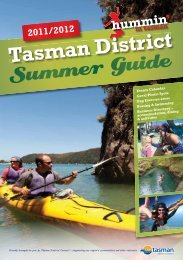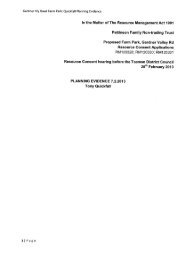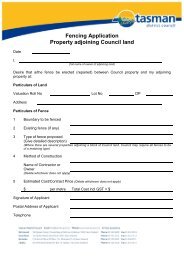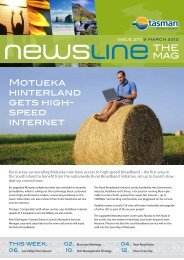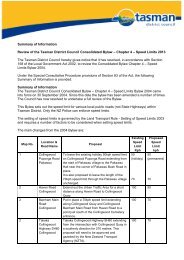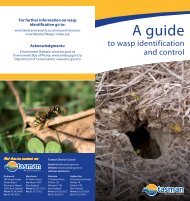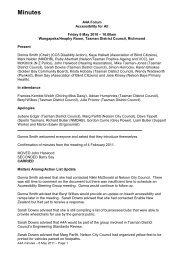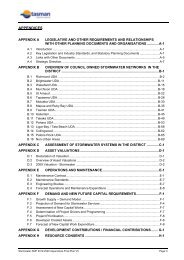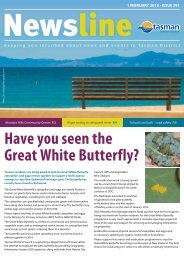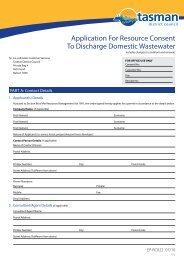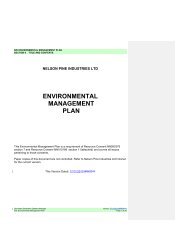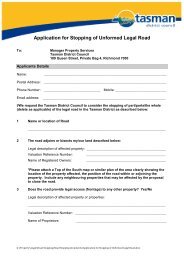Report RESC-11-03-05 NZTA Technical Audit of Local Roading ...
Report RESC-11-03-05 NZTA Technical Audit of Local Roading ...
Report RESC-11-03-05 NZTA Technical Audit of Local Roading ...
Create successful ePaper yourself
Turn your PDF publications into a flip-book with our unique Google optimized e-Paper software.
Tasman District 2010 FINAL <strong>Technical</strong> <strong>Report</strong><br />
3.5 Pavement Maintenance<br />
3.5.1 Sealed Network Condition Trends<br />
The <strong>NZTA</strong>’s PPFM (pF7-13, section F7.9, July 2009) requires annual roughness and condition rating, <strong>of</strong><br />
“all sealed roads carrying more than 500 vehicles per day”, with lesser trafficked roads rated at least<br />
every two years. Low volume routes with high proportions <strong>of</strong> heavy traffic should also be surveyed<br />
annually. This philosophy generally allows the identification <strong>of</strong> “at risk” routes (those carrying either<br />
heavy or high volumes) earlier in the deterioration cycle.<br />
There are fewer than 500 vehicles per day (vpd) on 81% <strong>of</strong> the Tasman network (and less than 100 vpd<br />
on 46%). Council regularly carries out both condition and roughness rating (high speed data) - Partial<br />
network rating is alternated with full network rating. The rating frequency is appropriate and results<br />
indicate reasonable consistency between successive surveys. However we note the need for attention<br />
to quality control and encourage Council to consider the change in 2008/9 results and how they relate<br />
to 2010 surveys (when they are available).<br />
As part <strong>of</strong> the <strong>NZTA</strong>’s monitoring <strong>of</strong> the implementation <strong>of</strong> approved activities and to meet its statutory<br />
responsibilities, the <strong>NZTA</strong> requires various reports from approved organisations. One <strong>of</strong> these is<br />
Annual Achievement <strong>Report</strong>ing (due 31 July, annually), which requires a summary <strong>of</strong> Council’s most<br />
recent pavement rating information. The following range <strong>of</strong> graphs and tables demonstrate network<br />
trends derived from annual returns to <strong>NZTA</strong> by Tasman District Council for the 2008/9 year.<br />
The STE, CI and PII indicators are derived from the input data shown below in Table 1.<br />
Table 1: Input Data to Pavement Indicators<br />
Indicator<br />
Smooth Travel Exposure (STE)<br />
(Note - no weighting <strong>of</strong> data.)<br />
Condition Index (CI)<br />
Pavement Integrity Index (PII)<br />
Input Data<br />
Percentage <strong>of</strong> travel undertaken on sealed roads with<br />
roughness less than 5.71 IRI (150 NAASRA counts/km).<br />
%age <strong>of</strong> alligator cracking<br />
%age area <strong>of</strong> scabbing<br />
%age area <strong>of</strong> potholes<br />
%age area <strong>of</strong> pothole patches<br />
%age area <strong>of</strong> flushing<br />
As for Condition Index (CI), plus<br />
%age <strong>of</strong> Rutting<br />
Average roughness<br />
%age <strong>of</strong> Shoving<br />
Smooth Travel Exposure (STE) for the Tasman network shows a steady trend with a marked<br />
improvement in the urban performance in the most recent survey (2008/09). Data quality should be<br />
confirmed and these results compared to the 2009/10 rating information as it becomes available.<br />
Overall, and as shown in Graph 1, the STE indicator appears to be tracking slightly better than the<br />
national average.<br />
12



